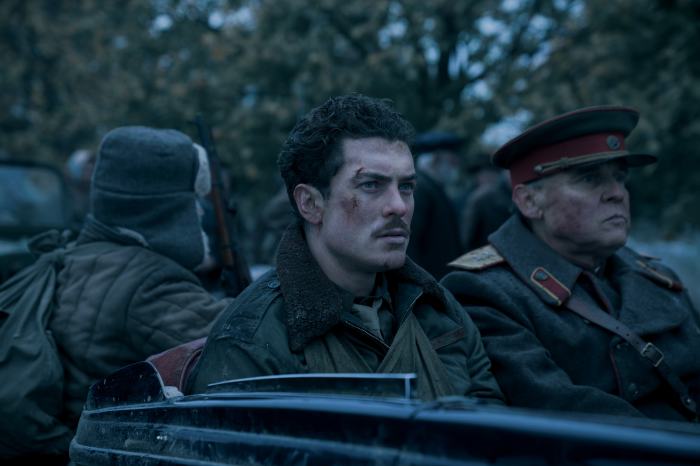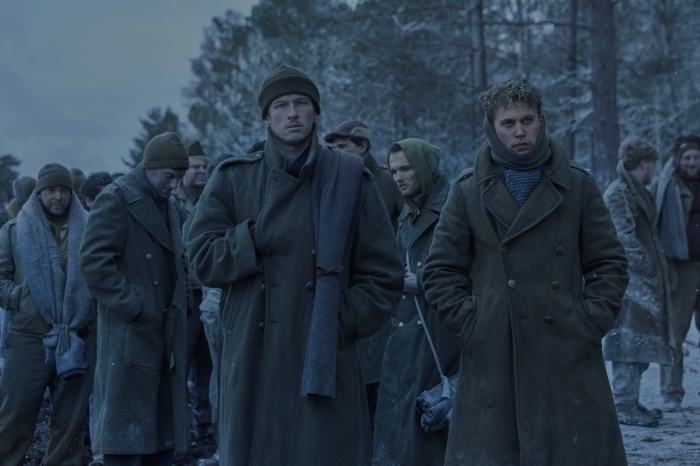By Dr Luke Truxal
Editorial note: On 26 January 2024, Apple TV+ launched the much-anticipated series Masters of the Air. This series follows the actions of the US 100th Bomb Group during the Combined Bomber Offensive in the Second World War. As the series is being aired, our Book Reviews Editor, Dr Luke Truxal, the author of Uniting against the Reich (2023), will critically review each episode.
In the final episode of Masters of the Air, we see the episode successfully bringing the plots of the US 100th Bomb Group to a satisfying conclusion. It did well as an episode designed to finish the series and bring it to a successful landing. During the episode, we see the major characters resolve their past and begin to face their futures. Major Harry Crosby struggles with the nature of the air war and toils with how he has changed during the war. This is something that he struggled with after the war, like most veterans. Lieutenant Colonel Robert Rosenthal saw the Holocaust first-hand as he toured a concentration camp after he was shot down and rescued by troops from the Soviet Union’s Red Army. After the war, Rosenthal participated in the prosecution of Nazi officials at Nuremberg for their roles in the Holocaust. Finally, we see Majors Gale Clevan and John Egan face the horrors of the march from Stalag Luft III to their new camp at Mooseberg. During the march, Egan finally embraces the leadership role he had tried to avoid throughout the series.
The episode begins with Rosenthal and the 100th Bomb Group attacking Berlin in February 1945. During the raid, Rosenthal is shot down for the second time in the war. As his plane falls out of formation, he makes his way towards the Soviet lines east of Berlin. By buying this time, he gave his crew the best opportunity to be rescued by the Soviets. After Rosenthal bails out and lands behind the Soviet lines, the viewers get their first glimpse of the nature of the fighting on the Eastern Front. German soldiers are shot as they are surrendering. This might be the only time we see the Eastern Front in a series produced by Tom Hanks and Stephen Spielberg, and they execute it well. The fighting on the Eastern Front was one without mercy, and the writers did not shy away from showing Soviet war crimes. After Rosenthal is rescued, he spends time behind the Soviet lines. At one point, he tours a concentration camp that the Red Army had liberated. He is clearly shaken by what he has seen. Later, before he is put on an aeroplane to begin his long circuitous route back to Thorpe Abbotts, he meets with a Jewish family. He starts to ask questions about what happened during the German occupation. As he begins to learn about the nature of the genocide conducted by the Germans, he is clearly shaken and changed by this experience. By the time he returns to Crosby at Thorpe Abbotts, he has no remorse for the German people suffering under the bombs after what he has seen.

Crosby himself is dealing with many changes in his life. During the latter months at Thorpe Abbotts, we can see that he is becoming more challenging to live with as the only original group member to remain with the 100th Bomb Group throughout the war. At one point, he physically assaults another officer for failing to have the equipment room ready for the combat crews as they are trying to get their parachutes for the upcoming raid. This is something that Crosby notes in his book, A Wing and a Prayer, on several occasions, which is partially why he was sent on leave to the United States. When Rosenthal returns, Crosby updates him on his life and the fact that he will become a father. Crosby doubts whether he will be a good father after everything he has gone through. He also hints at his doubts about the morality of some of the bombings that they are doing. Rosenthal lets Crosby know he will be a good father and tries to get him to put aside his doubts about the air war. This is another good discussion because it shows the divisions airmen felt over their attacks against Germany. It also shows how the war has changed Crosby and Rosenthal. Rosenthal gains confidence that they are doing the right thing in the air war after his experiences on the ground, but Crosby has doubts due to the destruction of German cities and significant losses of life.
Clevan and Egan are given short notice that they have only minutes to pack as they are about to leave Stalag Luft III with the Soviets driving towards the camp. This is the beginning of their march to a new camp, Stalag VII-A, located in Moosburg, Germany. On the march, we see the Americans witness the downfall of Nazi Germany within Germany itself. We still see the prisoners attacked and strafed by United States Army Air Force P-51 Mustangs, which misidentified them as a troop column. In another instance, we see the fanatical support for Hitler’s Germany in one of the guards participating in the march. At the same time, we see an armoured column of German soldiers pass the prisoners. Those in the armoured column clearly look beaten. In addition to the veterans who have seen too much combat in a war that they have clearly lost by this point, we also see the images of young boys and older men in the armoured formation. As the column gets closer to Moosburg, Clevan sees an opportunity for a number of other prisoners to attempt to escape. Realising that he will not make it, Egan obstructs the German guards pursuing Clevan and his comrades. This is where Egan really shines. Instead of trying to make a bolt for it, he helps his friend and comrades escape. Thus ensuring he would remain a prisoner for the remainder of the war. The story for Egan ends when he is liberated from Moosburg with the other prisoners by the US 14th Armored Division.

The episode ends with the ground personnel packing up Thorpe Abbotts and the 100th Bomb Group taking off to return home to the United States. While the aircrews fly back on their planes, the ground echelon returns to the United States via troop transport across the Atlantic. The series ends on a sombre note. During their final pre-flight check, Egan asks Clevan what he is thinking. Clevan responds by stating that he is thinking about the airmen they left behind. Due to the high attrition rate in the air war, many viewers struggled to connect with many of the new crews as the original members of the 100th Bomb Group were shot down. For men like Egan and Clevan, the losses of their comrades like Biddick and Bubbles, stuck with them long after the war. This brief moment tries to remind viewers of the high losses that the 100th Bomb Group and US Eighth Air Force suffered throughout the war.
Like previous episodes, this one has a couple of missed opportunities. First, seeing more of the US 332nd Fighter Group in this episode and the rest of the series would have been nice. Viewers never really saw the group conduct bomber escort missions, which it became known for throughout the air war. Additionally, there was an opportunity to cover Operation Thunderclap and the firebombing of Dresden from 13 to 15 February 1945. This would have provided better context for the viewers as Crosby and Rosenthal discuss the merits of the air war itself. Finally, I will state that the British spy plot that was dropped during the episode was the smart call to save airtime from tying off the other plot lines developed throughout the series. This decision did make me wonder why that story was even being told in the first place.
Overall, Masters of the Air has now become the best depiction of the American experience in the air war over Europe on screen. While this series has a lot of flaws, which I have noted throughout these reviews, it covers more ground than other depictions of the air war well. Also, it captures the nature of the fighting in ways that previous depictions could not be due to the technological limitations of their times. This series did a good job of paying homage to the experience of the American airman while also showing the brutality of air combat. Whereas previous depictions of air warfare chose to depict combat in the skies as more knightly duels or did not have the technological capabilities to fully capture the horrors of the air war, this series brought the struggles of the American airman front and centre. Scholars now have a series they can better use to talk about the air war with students and the public. I hope this series will inspire many young viewers to be the next generation of air power historians who usher in more scholarship on this subject at a time when it is most needed. While it is too early to tell, this series has renewed interest in the air war and the men who flew these planes into combat. If that is the only legacy of the television series, it has already contributed significantly to the field by renewing interest in the topic.
Dr Luke Truxal is an adjunct at Columbia State Community College in Tennessee. He completed his PhD in 2018 at the University of North Texas with his dissertation, ‘Command Unity and the Air War Against Germany.’ His previous publications include ‘Bombing the Romanian Rail Network’ in the Spring 2018 issue of Air Power History. He also wrote ‘The Politics of Operational Planning: Ira Eaker and the Combined Bomber Offensive in 1943’ in the Journal of Military Aviation History. In addition, Truxal is researching the effectiveness of joint air operations between the Allied air forces in the Second World War. He can be reached on Twitter at @Luke_Truxal.
Header image: Austin Butler in Masters of the Air. (Source: Apple TV+)
Watching Master’s of the Air series provided me a glimpse of what my Father-in-Law, Harry J Wurth went through in his WWII pilot training program. He was a pilot flying the B-17. Fortunately the war ended before he was to be shipped out to Europe. The series is a superb description of my own thoughts and ideas these men flying these war machines. The psychological trauma many went through and suffered during and after the war was real. Only today we call it PTSD and we assist our service men and women in dealing with it.
LikeLike